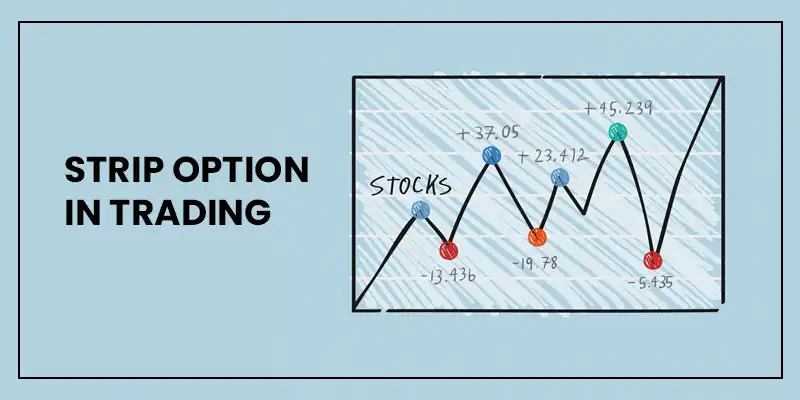A strip option strategy typically consists of a combination of one call option and two put options on the same underlying asset with the same expiration date and strike price. The structure is designed to provide a more significant number of puts than calls, reflecting an expectation of potential downward movements.
The strategy, however, is applied in situations where volatility is anticipated, and the option premiums reflect the cost of acquiring this position. This article explains the structure, mechanism, and general characteristics of strip option trading, with a focus on risk considerations and pricing behavior under varied market conditions.
Contents
- Structure and Mechanism
- Trading Characteristics
- Risk and Considerations
- Conclusion
- FAQs
Structure and Mechanism
In a strip option, selecting one call and two puts creates a net position that tends to respond more effectively to price declines than to rises. The asymmetrical position means that if the underlying asset experiences considerable downward movement, the puts may gain in value more substantially. Conversely, if the asset rises moderately, the call option may offer some compensation, but the overall profitability tends to favor scenarios with larger negative moves.
Implementing this strategy requires careful consideration of the premiums paid, the market volatility, and the expectations regarding the underlying asset. The pricing of the options is a function of several factors, including time to expiration, the volatility of the underlying asset, and the strike price’s proximity to the current market price.
Note: It is important to note that this structure is presented for informational purposes and does not imply any assurance of profit or suitability.
Read Also: How To Trade Futures And Options: A Step-By-Step Guide For Beginners
Trading Characteristics
Key aspects of strip option trading include volatility, cost factors, and time decay considerations.
- Volatility Consideration: The strip option strategy is commonly discussed in relation to expected market volatility. In scenarios involving significant price movement, especially downward, the value of put options may increase. However, if price movements are modest, the strategy may underperform due to premium outlay and time decay.
- Cost and Premium Impact: The net cost to enter a strip option position is determined by the combined premiums of both call and put options. Traders must consider the aggregate expense and ensure that expected gains, if any, justify this outlay. Additional transaction fees can affect the overall net outcome, so careful evaluation is essential. Premium levels and transaction costs may vary significantly based on market conditions and do not guarantee any particular outcome.
- Time Decay and Option Value: Time decay gradually reduces the value of both the call and put components of the strip. If the expected volatility does not occur, time decay may lead to a net loss. It is advisable to monitor option Greeks and duration to assess this effect better.
Risk and Considerations
Trading with strip options involves exposure to potential losses and does not guarantee positive outcomes. It is essential to understand that the results are influenced by market behavior, volatility levels, and cost structures. The inherent sensitivity to market volatility means that outcomes may vary based on the performance of the underlying asset and market conditions. The combined premium expenditure for the call and extra put options will result in losses if the price movement is less significant than anticipated. Understanding that the strategy is contingent upon market factors that may affect option premiums, time decay, and overall profit and loss is essential.
The structure of strip option trading allows for potential gains on downward trends, but it does not provide immunity from unfavorable movements. It is critical to assess each component, including market volatility and additional transaction costs, as these can influence the overall result.
Read Also: Understanding Margin And Leverage In Futures And Options Trading
Conclusion
Strip option trading focuses on positions that can benefit from notable price declines. It involves purchasing one call option alongside two put options, thereby creating an asymmetrical position. The strategy hinges on significant market movement and emphasizes the importance of premium costs and time decay. It is imperative to recognize that all options strategies, including the strip, require a thorough understanding of market mechanics and carry inherent uncertainties.
Investors or learners evaluating this strategy should do so with the understanding that all derivative strategies carry inherent risks and should be approached with a focus on informed risk management and regulatory compliance.
Disclaimer: Investment in the securities market is subject to market risks. Please read all scheme-related documents carefully before investing. The information provided in this article is for educational and informational purposes only and is not intended as investment advice. Trading in derivatives, including options, involves substantial risk and is not suitable for all investors. Past performance is not indicative of future results. Readers are advised to consult with their financial advisors before making any trading decisions.
FAQs
The strip option combines one call with two puts to target potential downside movements, differentiating it from other strategies using balanced option positions.
Traders may look at the strip option when market conditions suggest elevated volatility, in market conditions where higher volatility is anticipated, and there is a view that downside movement may outweigh upside potential. However, this view does not ensure favorable outcomes.
Transaction costs—including brokerage, taxes, and bid-ask spreads—can reduce the net payoff. These must be considered when evaluating the risk-reward profile of the trade.

